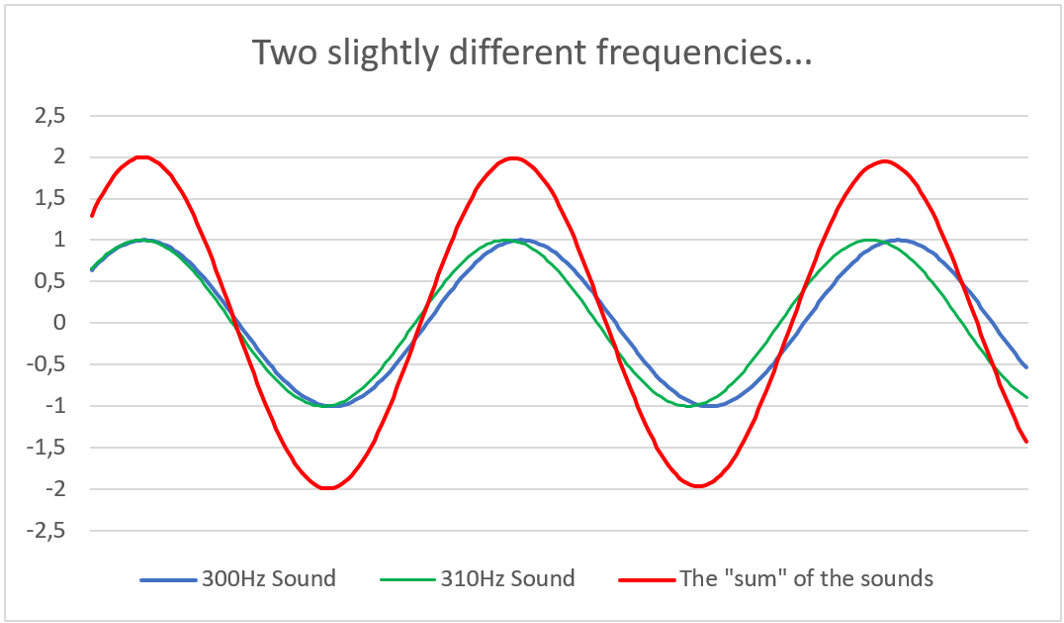The power of sound on the human body and mind
Several studies show that sound frequencies have a direct impact on brain activity, stress levels and even physical health. One such study, published in the Journal of Pain Research (PubMed, 2020), showed that listening to binaural rhythms at specific frequencies significantly reduced participants’ perception of acute pain, from an average rating of 5.2/10 to 3.4/10. These results pave the way for drug-reducing treatment options in healthcare settings.
Beyond pain relief, people around the world are exploring binaural beats and sonotherapy to reduce anxiety, improve sleep, stimulate concentration and promote emotional balance. This has led to growing interest from scientists, health professionals and wellness practitioners seeking to understand how different sound frequencies interact with brain function.

What This Article Will Reveal
🔬 The Science: How binaural beats and sound therapy affect the brain and body.
🧘 The Benefits: How they can help you with stress, sleep, focus, and even pain management.
📖 The Practical Guide: How you can integrate sound therapy into your daily life.
So, can sound truly transform your well-being? Let’s explore the facts, the science, and the experience of those who use it. 🎧✨
Binaural beats: the secret to hacking brain frequencies?
Binaural beats are an auditory illusion that occurs when two slightly different frequencies are presented separately to each ear. The brain perceives a third sound, called a binaural beat, which corresponds to the mathematical difference between the two frequencies. For example, if a 300 Hz sound is played in the left ear and a 310 Hz sound in the right, the brain perceives a binaural beat of 10 Hz.


This perceived beat can influence brainwave activity, encouraging the brain to align its waves with the frequency of the binaural beat – a process known as frequency-following response. Different binaural beat frequencies are thought to promote different mental states:
– Delta (≤4 Hz): Deep sleep and relaxation.
– Theta (4-8 Hz): Meditation and creativity.
– Alpha (8-14 Hz): Relaxation and stress reduction.
– Beta (14-30 Hz): Concentration and alertness.
Case study
Binaural beats and relaxation
A case study published in Frontiers in Human Neuroscience examined the effects of adding binaural beats to brown noise and music on the brains and physiology of four participants seeking to relieve stress. The study revealed that binaural beats had profound effects on the participants’ physiology, leading to improved brain function and a calmer state. As the beats were inaudible, these effects cannot be attributed to the placebo effect.
While these results are promising, it’s important to note that the research on binaural beats was conducted as part of a research project.
Sonotherapy: The healing vibrations of sound
For centuries, cultures around the world have used sound for therapeutic and spiritual purposes:
🔹 Tibetan singing bowls → used in meditation to induce relaxation and mental clarity.
🔹 Tuning fork therapy → vibratory frequencies applied to specific points on the body for healing.
🔹 Gong baths and crystal bowls → Employed in sound baths to create states of deep relaxation.
Today, sonotherapy, or sound therapy, concerns the use of sound frequencies to promote healing and well-being. It has been studied for a variety of medical and wellness applications:
🔹 Pain management: Sound therapy has been used to reduce chronic pain, particularly in cases such as fibromyalgia.
🔹 Cardiovascular health: Listening to low-frequency sound waves has been associated with a reduction in heart rate and blood pressure, contributing to stress reduction and heart health.
🔹 Mental health: Sound therapy reduces cortisol levels, helping to manage anxiety and symptoms of post-traumatic stress disorder (PTSD).
The benefits of sound therapy in your daily life.
Integrating binaural beats and sound therapy into your daily routine can offer many benefits, from relaxation and improved sleep to better concentration and pain management. Here’s how to use these sound therapies effectively:
Relaxation and stress relief
Optimum frequencies: Alpha waves (8-14 Hz) are ideal for calming the nervous system. Listening to binaural rhythms in this frequency range can promote relaxation and reduce stress.
Practical application: Set aside 15 to 30 minutes in a quiet space. Use headphones to listen to alpha binaural waves, concentrating on your breathing and letting the sound guide you into a state of relaxation.
Case study: A study published in Frontiers in Human Neuroscience showed that participants who listened to binaural rhythms at alpha frequencies experienced a significant reduction in their stress and anxiety levels.
Better sleep
Optimal frequencies: Delta waves (0.5-4 Hz) are associated with deep sleep. Binaural beats in this range can help improve sleep quality.
Practical application: Before going to bed, listen to delta-wave binaural beats for about 30 minutes. Make sure you’re in a comfortable environment, free from interruptions.
Case study: Research conducted by the Sleep Foundation indicates that listening to delta-frequency binaural beats can make it easier to fall asleep and improve sleep quality.
Productivity and concentration
Optimal frequencies: Beta waves (14-30 Hz) are linked to active concentration and alertness. Using binaural rhythms in this range can boost productivity.
Practical application: During work or study sessions, play beta wave binaural rhythms in the background. Use headphones for optimum effect, and consider using tracks that combine these frequencies with nature sounds to enhance concentration.
Case study: A report from Verywell Mind suggests that beta-frequency binaural beats can improve attention and task performance.
Our recommendation: Use an application like Melodia Therapy with 30-minute cycles to benefit from the effects within the Pomodoro technique and boost your efficiency.
Fréquences optimales : Les ondes bêta (14-30 Hz) sont liées à la concentration active et à la vigilance. L’utilisation de rythmes binauraux dans cette gamme peut stimuler la productivité.
Application pratique : Pendant les sessions de travail ou d’étude, jouez des rythmes binauraux d’ondes bêta en arrière-plan. Utilisez un casque pour un effet optimal et envisagez d’utiliser des pistes qui combinent ces fréquences avec des sons de la nature pour améliorer la concentration.
Étude de cas : Un rapport de Verywell Mind suggère que les battements binauraux de fréquence bêta peuvent améliorer l’attention et l’exécution des tâches.
Notre recommandation : Utilisez une application comme Melodia Therapy avec des cycles de 30 minutes pour profiter des effets au sein de la technique Pomodoro et booster votre efficacité.
Pain management
Healthcare application: Some hospitals and wellness centers use sound therapy, including gongs and singing bowls, to combat pain and promote general well-being.
Practical application: Participate in guided sound therapy sessions, such as gong baths or meditations with singing bowls, either in person or via reputable online platforms.
Case study: The Times explains in an article how people have found relief from physical discomfort through gong sessions, highlighting the potential of sound therapy in pain management.
PRACTICAL GUIDE: INTEGRATING SOUND THERAPY INTO YOUR ROUTINE
For those interested in exploring binaural beats and sound therapy, Melodia Therapy is one of the most promising and scientifically supported applications. This innovative platform combines three key elements to maximize therapeutic benefits:
🎧 Binaural beats : Designed to entrain brain waves, promoting relaxation, concentration, sleep and pain relief.
🌿 3D Nature Sounds : Immersive soundscapes that improve mental clarity, reduce stress and promote emotional balance.
🎵 Relaxing music : Soothing compositions that work in harmony with frequencies to create a deeply calming effect.
The benefits of Melodia Therapy
✅ Multi-level sound healing: The application fuses scientific audio techniques with natural and musical elements for an enhanced therapeutic experience.
✅ Scientific approach: Built on brainwave entrainment research, aligning with modern discoveries in sound therapy.
✅ Personalized wellness solutions: Users can select sessions based on their specific goals, whether relaxation, sleep, productivity or pain relief.
✅ Accessible and easy to use: Designed for seamless integration into daily routines, making sound healing accessible to all.
By blending binaural beats, nature sounds and music, Melodia Therapy offers a holistic, scientific approach to wellness. 🎶✨
Our recommendations for use
🎧 Download the app and explore the different therapeutic soundscapes.
⏳ Spend 10 to 30 minutes a day in a quiet, comfortable environment.
🔊 Use headphones for binaural beats or good speakers.
💡 Experiment with different sound combinations and evaluate the effects.
The future of sound therapy – a promising but evolving field
The use of binaural beats and sound therapy as well as wellness tools has grown considerably in recent years, supported by scientific curiosity and patient testimonials. While existing research suggests promising benefits – stress relief, improved sleep, enhanced concentration and pain management – the field of non-conventional medicine still requires further study to fully understand its mechanisms and long-term effects.
A new complement to traditional medicine
In hospitals and healthcare facilities, the integration of sound therapy is attracting growing interest, particularly in the field of chronic pain management. Chronic pain, such as fibromyalgia, neuropathic pain and post-surgical discomfort, often requires long-term treatment, which can lead to heavy dependence on analgesics, including opioids. Several clinical studies have suggested that sound therapy can help modulate pain perception, potentially enabling analgesic doses to be reduced while maintaining patient comfort.
A platform for the well-being of patients and caregivers
Jane Jobs is committed to facilitating access to the best applications for improving patient care and lightening the burden on caregivers. That’s why our platform integrates a wide range of solutions, including sound therapy, therapeutic music and relaxation tools tailored to hospital needs.
👉 Tailor-made support for every department
👉 Easy access to proven solutions
📩 Contact us to find out more!
Disclaimer.
This article is for information only.
If you have any health problems, please consult your doctor.






